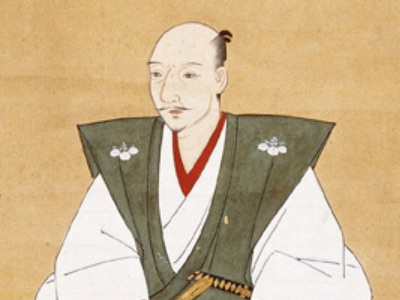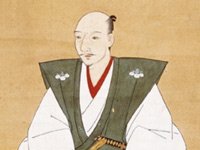Oda Nobunaga was born on June 23, 1534, in the Owari domain, and was given the childhood name of Kippōshi (吉法師). He was the second son of Oda Nobuhide, a deputy shugo (military governor) with land holdings in Owari Province. He is said to have been born in Nagoya Castle, although this is subject to debate. Through his childhood and early teenage years, he was well known for his bizarre behavior and received the name of Owari no Ōutsuke (尾張の大うつけ, The Big Fool of Owari). He was known to run around with other youths from the area, without any regard to his own rank in society. With the introduction of firearms into Japan, however, he became known for his fondness of tanegashima firearms.
-
Outline of Oda Nobunaga (1534-1582)

HISTORIC PEOPLE
Oda Nobunaga (1534-1582)
Oda Nobunaga was a powerful Daimyō of Japan in the late 16th century who attempted to unify Japan during the late Sengoku period. Nobunaga is regarded as one of three unifiers of Japan along with his retainers Toyotomi Hideyoshi and Tokugawa Ieyasu. During his later life, Nobunaga was widely known for most brutal suppression of determined opponents, eliminating those who by principle refused to cooperate or yield to his demands. View Oda Nobunaga (1534-1582) »
Early Life: He was known to run around with other youths from the area, without any regard to his own rank in society. With the introduction of firearms into Japan, however, he became known for his fondness of tanegashima firearms.
Unification of Owari Province: Although Nobunaga was Nobuhide's legitimate successor, the Oda clan was divided into many factions, and the clan was technically under the control of Owari's shugo, Shiba Yoshimune.
Rise to Power: Nobunaga revealed his ambition to conquer the whole of Japan. He also started using a new personal seal that read Tenka Fubu (天下布武), which means "All the world by force of arms" or "Rule the Empire by Force".
Campaign against rival daimyō: During the siege of Nagashima, Nobunaga inflicted tremendous losses to the Ikkō-ikki resistance who opposed samurai rule. The siege finally ended when Nobunaga surrounded the enemy complex and set fire to it, killing tens of thousands.
Coup at Honnō-ji and death: En route to Chūgoku region, Nobunaga stayed at Honnō-ji, a temple in Kyoto. Since Nobunaga would not expect an attack in the middle of his firmly-controlled territories, he was guarded by only a few dozen personal servants and bodyguards.
Nobunaga, Hideyoshi, and Ieyasu: Ieyasu had shared his childhood with Nobunaga as a hostage of the Oda clan. Though there were a number of battles between him and the Oda clan, Ieyasu eventually switched sides and became one of Nobunaga's strongest allies.
Policies: Nobunaga's dominance and brilliance was not restricted to the battlefield, for he also was a keen businessman and understood the principles of microeconomics and macroeconomics. First, in order to modernize the economy from an agricultural base to a manufacture and service base, castle towns were developed as the center and basis of local economies.

Oda Nobunaga (1534-1582)
Oda Nobunaga was a powerful Daimyō of Japan in the late 16th century who attempted to unify Japan during the late Sengoku period. Nobunaga is regarded as one of three unifiers of Japan along with his retainers Toyotomi Hideyoshi and Tokugawa Ieyasu. During his later life, Nobunaga was widely known for most brutal suppression of determined opponents, eliminating those who by principle refused to cooperate or yield to his demands.
- Early Life
- Unification of Owari Province
- Rise to Power
- Campaign against rival daimyō
- Coup at Honnō-ji and death
- Nobunaga, Hideyoshi, and Ieyasu
- Policies
| Oda clan | |
|---|---|
 |
Born: 23 June 1534 Nagoya, Owari, Japan
Died: 21 June 1582 (aged 47) Honnō-ji, Kyoto, Japan
Notable: The first "Great Unifier" of Japan



RESOURCES
This article uses material from the Wikipedia article "Oda Nobunaga (1534-1582)", which is released under the Creative Commons Attribution-Share-Alike License 3.0.
© Stories Preschool. All Rights Reserved.
"Building Cool Educational Stuff for children and adults!"


Historic Battles
Wars and military campaigns are guided by strategy, whereas battles take place on a level of planning and execution known as operational mobility.
View Historic Battles »


Historic People
A historical figure is a famous person in history, such as Alexander the Great, Admiral Yi Sun-Shin, Abraham Lincoln, George Washington, Christopher Columbus, or Napoleon Bonaparte.
View Historic People »


Historic Timeline
Describes the history of humanity as determined by the study of archaeological and written records. Ancient recorded history begins with the invention of writing.
View Historic Timeline »

Historic Legends
Beings in myths are generally gods and goddesses, heroes and heroines, or animals and plants. Most myths are set in a timeless past before recorded time or beginning of the critical history.
View Historic Legends »

Sports World
Includes competitive games which, through casual or organized participation, aim to use, maintain or improve physical ability and skills while providing enjoyment to participants.
View Sports World »

Untold Stories
If you have any questions, feedback or suggestions for us, we'd like to hear from you. Please feel free to contact us!
Contact Us

Historic Battles
Wars and military campaigns are guided by strategy, whereas battles take place on a level of planning and execution known as operational mobility.
View Historic Battles »

Historic People
A historical figure is a famous person in history, such as Alexander the Great, Admiral Yi Sun-Shin, Abraham Lincoln, George Washington, Christopher Columbus, or Napoleon Bonaparte.
View Historic People »

Historic Timeline
Describes the history of humanity as determined by the study of archaeological and written records. Ancient recorded history begins with the invention of writing.
View Historic Timeline »

Historic Legends
Beings in myths are generally gods and goddesses, heroes and heroines, or animals and plants. Most myths are set in a timeless past before recorded time or beginning of the critical history.
View Historic Legends »

Sports World
Includes competitive games which, through casual or organized participation, aim to use, maintain or improve physical ability and skills while providing enjoyment to participants.
View Sports World »

Untold Stories
If you have any questions, feedback or suggestions for us, we'd like to hear from you. Please feel free to contact us!
Contact Us
Historic Battles
Wars and military campaigns are guided by strategy, whereas battles take place on a level of planning and execution known as operational mobility.
View Historic Battles »

Historic People
A historical figure is a famous person in history, such as Alexander the Great, Admiral Yi Sun-Shin, Abraham Lincoln, George Washington, Christopher Columbus, or Napoleon Bonaparte.
View Historic People »

Historic Timeline
Describes the history of humanity as determined by the study of archaeological and written records. Ancient recorded history begins with the invention of writing.
View Historic Timeline »

Historic Legends
Beings in myths are generally gods and goddesses, heroes and heroines, or animals and plants. Most myths are set in a timeless past before recorded time or beginning of the critical history.
View Historic Legends »

Sports World
Includes competitive games which, through casual or organized participation, aim to use, maintain or improve physical ability and skills while providing enjoyment to participants.
View Sports World »

Untold Stories
If you have any questions, feedback or suggestions for us, we'd like to hear from you. Please feel free to contact us!
Contact Us